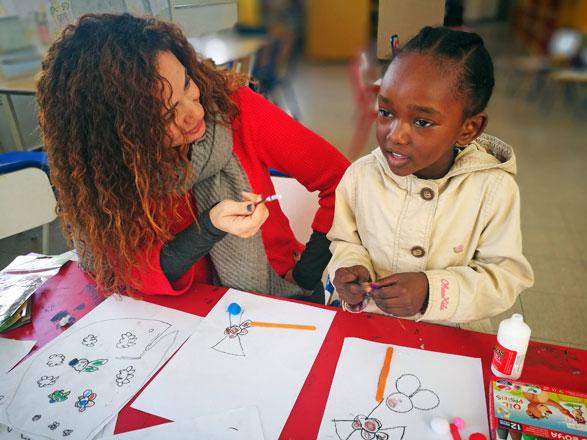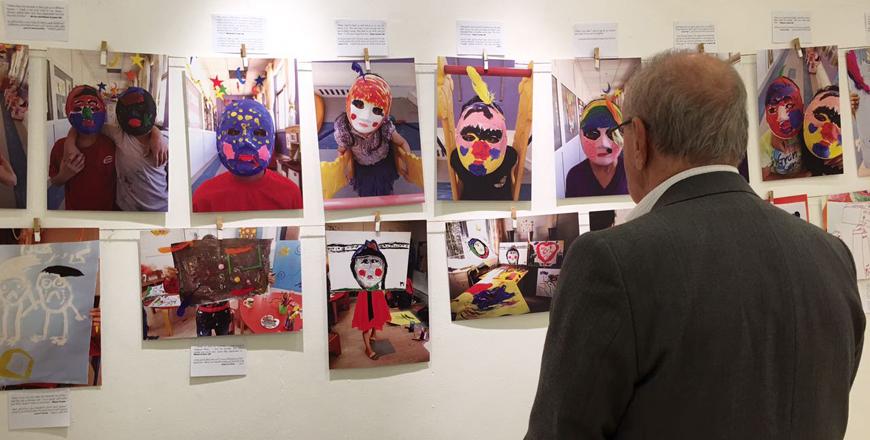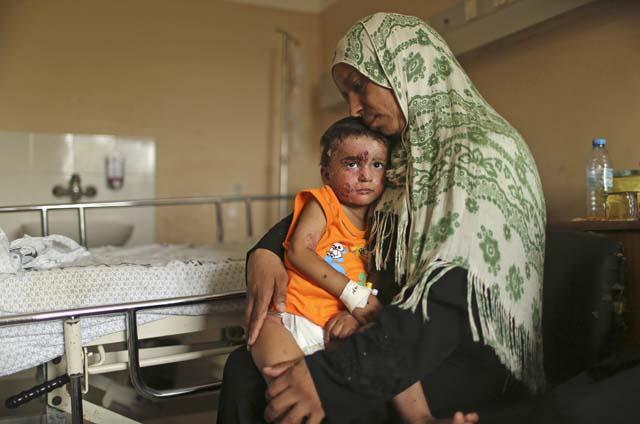You are here
Amman-based therapist prescribes art to treat trauma, build self-empowerment
By Yasmeen Kanaan - Mar 16,2019 - Last updated at Mar 16,2019

In this undated photo, Kaynouna Art Therapy Centre founder Shireen Yaish (left) sits with a beneficiary during an art therapy session. Yaish established the centre in 2012 as one of the first in the Arab region to use art therapy to treat mental health issues (Photo courtesy of Kaynouna Art Therapy Centre )
AMMAN — While thinking outside the box can get us off the beaten path, a modern approach to treating trauma and other mental health issues aims to get people thinking outside the pillbox to save them serious chronic fatigue.
The practice of expressing oneself genuinely and casually can allow us to make sense of experiences that are coded non-verbally, according to art therapists. In that sense, art therapy has become a modern approach to treating the epidemic of being conditioned to internally suppress vulnerability, anxiety, depression and even trauma.
Kaynouna, an art psychotherapy centre founded in 2012 by art psychotherapist Shireen Yaish, uses creative therapeutic approaches to empower people to reach within and get in touch with the truth and answers to their underlying problems, according to Yaish.
“Behind closed doors, everybody needs to heal no matter how resistant you might expect them to be,” Yaish said in an interview with The Jordan Times. She added that Kaynouna provides a safe space for people to express, process and contain their feelings in a healthy manner.
Yaish said she had always thought about giving back to her community, and founded Kaynouna the minute she graduated from Goldsmith College at the University of London in 2012.
“I had been doing a lot of reading when I first applied to the MA in Art Psychotherapy programme. I knew it was my calling and I prepared and worked hard to introduce this form of therapy to Jordan.”
In answer to a question on why she chose to practice art therapy rather than other forms of therapy, Yaish said: “Art has always been my way to expressing and dealing with my feelings... I am a big believer in art psychotherapy’s therapeutic ability, especially for those who find it difficult to verbalise their feelings.”
Medication might not always hit at the root of mental illness, Yaish said, adding that art therapy can help pave the way for a creative manifestation of a beneficiary’s pain and help them achieve a sense of fulfilment.
“Art psychotherapy focuses on building the self-empowerment, self-confidence and self-soothing skills of beneficiaries.”
Yaish, with her certificate in Trauma Informed Art Therapy from the Trauma-Informed Practices and Expressive Arts Therapy Institute and Learning Centre, also utilises art therapy to provide ways for beneficiaries to manifest their traumas outside their bodies and bring buried feelings to the surface, as the cost of burying emotions can extend beyond depression, she said.
“Facing our stories and taking the time needed to heal [under the care of a specialised art psychotherapist or any creative therapies specialist] is what we as humans need to develop, grow and blossom. Feelings that are not dealt with are often acted out in our actions, in our decision making and in relationships we have in our lives,” Yaish said.
“Our bodies, as well, often react to difficult feelings that we decide to bury [in ways such as] anxiety, panic attacks and depression.”
According to the Art Therapy Sourcebook by Cathy Malchiodithe, founder of the Trauma Informed Practices and Expressive Arts Therapy Institute and a board-certified professional art therapist, the healing aspect of art is not only attributed to the expressive factors linked to it, but also to the fact that art is a universal language where verbal communication is not required. The artwork is a symbolic communication that allows the therapist to gain insight into experiences that the beneficiary might not be even aware of or unable to directly exchange.
Even in cases of physical illness, art therapy can “help people come to a feeling of being healed rather than cured; meaning that the person has reached psychological or spiritual well being, though his or her illness is still present”, Malchiodi said in the book.
Randy Vick, chairman of the master’s programme in art therapy at the School of the Art Institute of Chicago, told WebMD that “the beauty of art is that it can be so personal and idiosyncratic”.
“The essence of art therapy is to explore the making of the art product as well as the art process, [for beneficiaries] to find understanding of themselves in their work,” he added.
“I always say that the best way to reflect and understand your feelings is to make art. It doesn’t have to be pretty art, it doesn’t have to be what is expected of you. It needs to be real and spontaneous, so you could get to know yourself and understand yourself... Once these feelings are externalised, they become less threatening and have less effect on your here and now, and your future,” Yaish says on her website.
Kaynouna has worked with individual cases involving depression, anxiety, social phobia, anger and children of divorce, as well as collective trauma. In order for such therapeutic processes to flow serenely, Yaish said she first focuses on establishing trust with the beneficiaries.
“Trust is gained through time. There are times in the beginning of the art therapy groups, where I encounter a lot of resistance to the art therapy process, and there are other times when I face close to none,” Yaish said. “Each beneficiary or group is different — and each is approached in accordance to their need. Yet boundaries are usually important and they help with the trust process. Starting on time is one example... being consistent and available all play a role in building trust.”
Kayanouna has not only run projects in Jordan, but also implements classes in Lebanon, Palestine, the UAE and other Arab countries. Yaish said one of her most moving experiences occurred during a programme in Gaza.
“The art psychotherapy journey turned out to be strong and deep, and we realised that the children, women and men [in Gaza] tend to forget their own personal story. They are bombarded with images of their collective story online and on TV, it is discussed at home, in schools and in the streets; they hear so many opinions of their story that they forget their own opinions and feelings and who they really are,” she said.
Yaish is also uses interactive elements as a way to invite people to practice art therapy. Her ongoing initiative “Selfiekuna — Empowering Women Through Art” which started out as an online competition two years ago, has reached thousands of Yemini, Syrian, Palestinian, Jordanian, Sudanese, Iraqi, Lebanese and Kurdish women, Yaish told The Jordan Times.
“Through Kaynouna, we train teams, provide them with supervision, develop curricula specifically for them and offer experiential art psychotherapy groups,” the centre’s founder said. “We are hoping to make art therapy an accessible education and profession for future art therapists in the region through long term training and courses.”
Related Articles
AMMAN — Although Wafaa Khalil did not know how to paint, the idea of participating in psychological art therapy appealed to her.The 21-year-
In a ward at Shifa, Gaza's largest hospital, child therapist Rabeea Hamouda is trying to elicit a response from two small brothers, Omar and Mohammed, aged three and 18 months, hoping for some words or perhaps a smile.
AMMAN — Advocating for the use of art in expressing oneself and enhancing learning capacities, Jordanian Ola Khorchid called for the develop



















